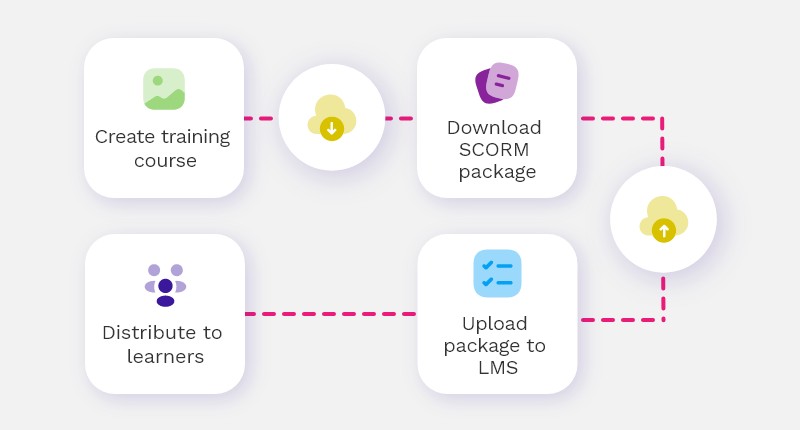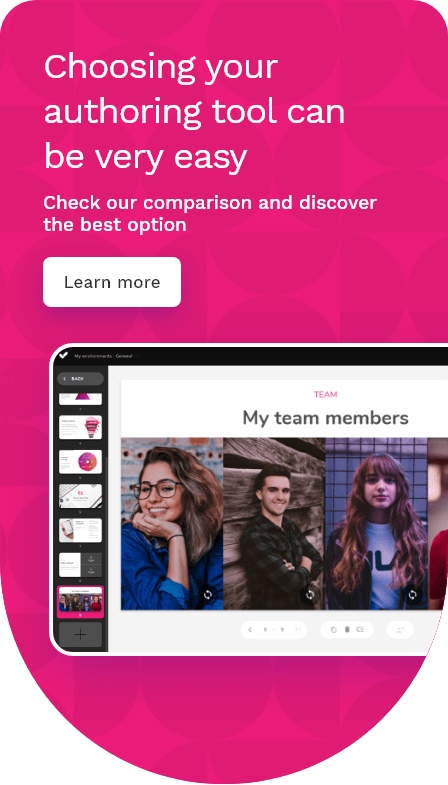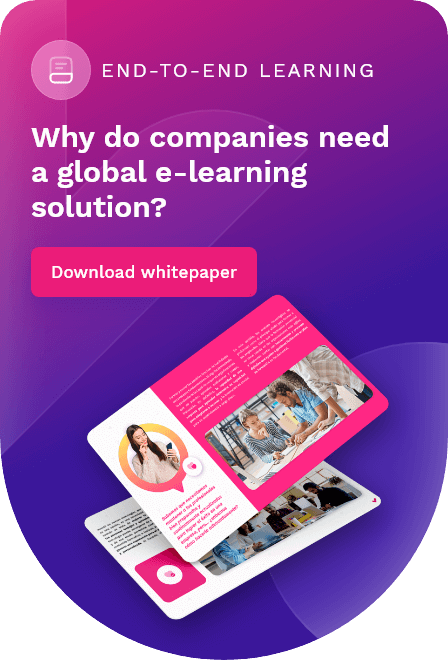Table of contents
ToggleIf you’re new to the world of e-learning, chances are you have come across the term “e-learning standards” or more concrete acronyms like SCORM, ADL, and AICC. While they might seem intimidating to someone who is unfamiliar with their meaning, it’s essential to understand them if you want to create high-quality e-learning content.
Below, we explore what e-learning standards are, along with their purpose and some of the most common standards in the industry.
What are standards?
Standards are specifications or guidelines for products or services that are created by groups of industry experts, governments, and other entities.
Some examples of standards in the technology industry may refer to data privacy and customer information such as the Payment Card Industry (PCI) and Data Security Standard (DSS) when handling credit card information or the Organization Control 2 (SOC 2) which is a voluntary standard with guidelines on how to handle customer data.
Adhering to already existing standards or developing new ones is important for technology companies because they can save time and money, help understand specific market requirements, structure your industry, and drive the market.
As per the IEEE SA (Institute of Electrical and Electronics Engineers Standards Association) : “…by participating in standards development, companies can help shape and capitalize on the future of technology, which helps to reduce development time and cost, and enables participants to gain insights to better align their products and services with industry opportunities… assure compliance with commercial and other requirements, and to enhance their brand by building trust with customers and other stakeholders.”
What are e-learning standards?
In the case of the e-learning industry, standards refer to the guidelines and specifications that determine how e-learning courses should be structured, developed, and handed over.
These guidelines can help determine how to track learner activities and experience, integrate e-learning multimedia to structure content, enhance the interoperability between different learning systems, or follow criteria to create courses that are accessible to all learners.
What are the objectives of e-learning standards?
E-learning standards aim to make sure different platforms, technologies and content work seamlessly together. By adhering to these standards, the online teaching and learning process becomes more effective, accessible, and scalable. E-learning standards have many purposes, including interoperability, reusability, durability, accessibility, and scalability.
- Interoperability
Achieving interoperability means that different online education platforms and systems can work and interact seamlessly together. This makes educational resources easy to share across different platforms and means training managers don’t have to sacrifice functionality or quality in the process.
- Reusability
When learning materials are designed and developed following certain standards, they can be structured in a way that allows companies to reuse them in different contexts. Reusability maximizes time and resources, by covering a range of learning objectives with the same content.
- Durability
E-learning standards also aim to guarantee that content lasts over time. This involves ensuring that learning materials are compatible with future updates and emerging technologies to ensure it’s relevant in years to come.
- Accessibility
Another key objective of e-learning standards is accessibility, which means providing educational content to everyone, regardless of their abilities or limitations. Standards like WCAG ensure that content is accessible to people with hearing, visual, motor, or cognitive impairments.
- Scalability
Lastly, scalability refers to how well systems and platforms can adapt to growing demand. Scalable software and content should be able to extend beyond its original scope to accommodate more learners.
Common e-learning standards: An overview
Currently, there are various e-learning standards compatible with different course creation platforms and learning management systems. Each of them has its pros and cons which is why your choice should be based around your organization’s specific training objectives.
AICC
The Aviation Industry Computer-Based Training Committee (AICC) is one of the earliest versions and the pioneer of e-learning standards, which originated in the aviation industry. It is used to transfer information of your e-learning courses to the LMS via the HTTP AICC Communication Protocol.
Advantages
- Highly secure. E-learning course data is transferred to the LMS securely via the HTTP protocol. This can be beneficial for companies that work with highly sensitive information.
- Simple communication protocol. The use of HTTPS/HTTP protocols are simpler to implement than other ones.
- Flexible deployment. It allows for content to be stored in separate servers or domains.
Disadvantages
Complex. Uploading the courses into the LMS is complex and requires various steps.
- It is difficult to learn. If users do not have a programming background it is difficult to implement.
- Limitations. It has data tracking, course interaction, and mobile support limitations.
- It is an outdated standard for newer authoring tools.
AICC today
Since the dissolution of the committee the AICC standard has become outdated. Since then, there have not been any updates to the standard. Nevertheless, there are still legacy LMS systems that still use it, so it’s a good idea to still consider it when working with older LMS systems.
xAPI
Experience API, also known as Tin Can API, is another important standard in the e-learning world. Developed by the Advanced Distributed Learning (ADL) initiative of the U.S. Department of Defense, xAPI allows tracking and recording of student learning experiences across various contexts and devices. xAPI is flexible, modern, and compatible with mobile, social, and real-world activities.
Advantages
- Capability of tracking different learning events. xAPI is capable of tracking different events or interactions throughout different touchpoints in the learner journey.
- Collection of detailed data. The xAPI is also able to collect very well-defined data of the learner’s interactions.
- Tracking and reporting in real-time. xAPI can track the progress of users in real-time across multiple sources.
- Interoperability and system integration. This means that information can be exchanged between different systems and platforms.
- Analytics and insights. With xAPI, you can extract rich data and insights of each individual learner and their performance.
- Multi-device support. An advantage is that it supports multiple devices (smartphones, tablets, and laptops).
Disadvantages
- Relatively new standard. Since xAPI is one of the newest standards, it is not as widely used as other standards such as SCORM or AICC. Especially in legacy systems.
- Statements. The creation of statements (actor, verb, object) is up to each provider. There’s no standardization for the creation.
xAPI today
In conclusion, xAPI has many advantages, and is a powerful specification that allows to track the performance of learners throughout the learning lifecycle. Since its inception, 10 years ago, Experience xAPI has come a long way. In 2023 xAPI 2.0 has become the first open-source specification to become an IEEE (Institute of Electrical and Electronics Engineers) and LTSC (Learning Technology Standards Committee) standard in 2023. There’s no doubt, it will continue to be implemented throughout many new learning software.
LTI
Learning Tools Interoperability (LTI) was developed by IMS Global Learning Consortium to enable the integration of external tools and applications within an LMS
Advantages
- Facilitates connection. It allows data connection between different learning platforms.
- Access of additional resources. Educators and students can access additional resources and third-party teaching tools without leaving the main LMS environment.
- Highly secure. The newer version has advanced security to protect the data of the students.
- More intuitive. With LTI Advantage adding courses is more intuitive since it is designed to allow plug-and-play integrations.
Disadvantages
- No widespread use. Not all LMS systems use LTI, for example Google Classroom or Microsoft Teams does not support the standard.
- Limited data access. LTI is not able to access data from all touchpoints within an LMS, for example it cannot communicate with the user’s calendar.
- Not consistent. Since the app appears in an iframe, LTI will look different depending on the location the user launches it from.
- Can’t see enrollments outside course. LTI is not able to detect enrollments of courses that have not yet launched within the LTI tool.
LTI today
Although LTI might not be a perfect fit for all the needs of an LMS system, it should be considered. The newer version LTI Advantage, also adds another layer of benefits, namely advanced protection of sensitive user data and the ability of linking to third-party tools outside the LMS environment making it very flexible and allowing it to improve the learner’s experience.
SCORM
Sharable Content Object Reference Model (SCORM) is one of the most popular and widely adopted e-learning standards. Like xAPI, it was also developed by ADL and defines technical specifications and rules for creating online learning content compatible with different LMSs.
If you want to know more about SCORM, check out this article.
Advantages
- Facilitates reuse of content. The main objective of SCORM is to facilitate the reuse of educational content across different platforms.
- Tracking of student experiences. This standard tracks and stores data about student experiences, including when they accessed content, how much time they spent, and their scores, in any compatible LMS.
- Courses 24/7. With SCORM E-learning content to be viewed from a browser. This means that students can interact with their courses 24/7.
- Very flexible. If at some point you change your LMS provider, you can continue to use existing courses on the new LMS platform.
- Access points. Users can access their courses directly where they left off.
Disadvantages
- Complexity. SCORM is a complex standard that needs expertise to implement.
- Lack of integration. It is not able to communicate or exchange data with other systems.
SCORM today
SCORM is a very popular standard that has been broadly adopted by the e-learning industry since its creation in 2000 and has gone through several revisions. SCORM 1.2 released in 2001, is considered one of the most stable and reliable versions. The last revision was released in 2004, with a total of four editions. The SCORM 2004 version has enhanced several features including added more flexibility and control of sequencing and learning activities, interoperability and conformance testing improvements, as well as content delivery and tracking.
Comparative table of e-learning standards
| Standard | Advantages | Disadvantages |
|---|---|---|
| AICC |
- Highly secure via HTTP protocol. - Simple communication protocol. - Content can be stored in several servers. |
- Uploading courses is complex. - To implement you need programming knowledge. - Data tracking, course interaction, and mobile support limitations. |
| xAPI |
- Able to track events and interactions from multiple sources. - Extract rich data and insights of individual learner performance. -Supports multiple devices (smartphones, tablets, and laptops). - Collection of detailed interaction data. - Tracking and reporting in real-time across multiple sources. |
- It is the newest standard (2013), some legacy systems might not be compatible. - Creation of statements (actor, verb, object) is not standardized. |
| LTI |
- Allows data connectionbetween different learning platforms. - Access to third-party tools. - Hightly secure. -Very intuitive with plug-and-play integrations. |
- It is not widely used. - It has limited access to data within LMS. - Experience of user is not consistent. - Course enrollment is not detected if it has not been launched. |
| SCORM |
- Facilitates reuse of content. -Tracks and stores data about student experiences. - Students can interact with their courses 24/7 via browser. - Very flexible. If you change to a different LMS existing courses can be used. - Users can access their courses directly where they left off. |
- Needs expertise to implement. - Not able to exchange data with others systems. |
Is it essential to work with e-learning standards?
E-learning standards play a crucial role in the success of online education. As we have seen, they can enable more effective and accessible learning experiences for both training managers and students. If you aim to develop high-quality content with these advantages in mind, working in line with e-learning standards is an essential consideration.
Now that you understand what e-learning standards are and are familiar with some of the most common ones, it’s time to start creating outstanding e-learning courses. isEazy offers innovative e-learning solutions for any training need. Find the perfect tool for your project or combine them for extraordinary results.















